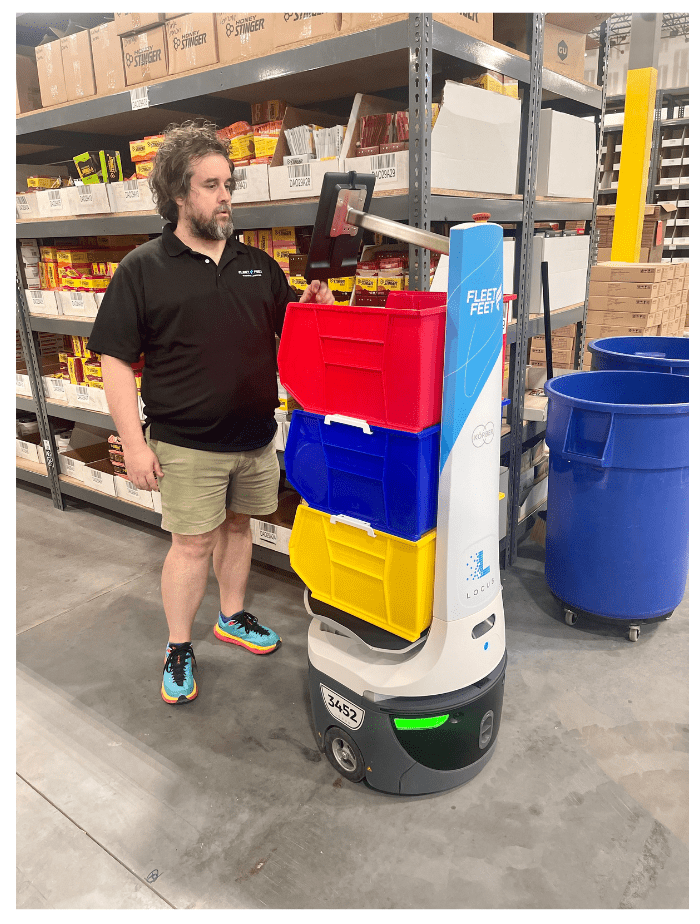On-Demand Webinar: The P2G Advantage
On-Demand Webinar: The P2G Advantage LEARN MORE
Human-Robot Collaboration in the Warehouse: Lessons Learned
Mary Hart, Senior Content Marketing Manager

Warehouse operations are evolving rapidly, with human-robot collaboration emerging as a cornerstone of modern efficiency and productivity. This shift has brought what was once the world of science fiction from movies and TV shows into reality with robots and humans working together. As these technologies become more integrated, they are redefining workflows and setting new standards for warehouse operations. The synergy between humans and robots is not only enhancing productivity but also creating safer and more dynamic work environments.
In an episode of “Warehouse Automation Matters,” I had the pleasure to speak with Anthony Pendola of Fleet Feet and John Santagate of Körber Supply Chain Solutions about how the integration of autonomous mobile robots (AMRs) has not only improved operations but also enhanced the work environment for associates.
Bringing Warehouse Collaboration to Life
The partnership between Fleet Feet and Körber began as Fleet Feet sought to upgrade its warehouse management system to align with their new ERP solution. Initially, integrating AMRs seemed out of reach, but discussions with Körber revealed this goal was closer than anticipated.
As Santagate explained, "Fleet Feet approached us to implement technologies to improve warehouse operations. We identified that our Warehouse Edge WMS was a great fit for their operation and saw an opportunity to leverage some autonomous mobile robotics."
Pendola echoed this, sharing, "We realized Körber's relationship with Locus Robotics could help us incorporate AMRs sooner than expected. We decided to go live with a new ERP program, a new WMS, and AMRs all at once."
Optimizing Warehouse Resources
This partnership started with a new (aka “greenfield”) distribution center. Pendola and the Fleet Feet team designed the warehouse space with the help of Körber and Locus to ensure the facility was optimized from the start for when they went live with the new systems.
The key to the smooth transition — besides planning and optimization — was defining clear roles for both the human associates at Fleet Feet and their robotic colleagues. Fleet Feet currently uses LocusBots for picking orders for their company-owned stores, but they plan to extend the use of the AMRs to e-commerce picking soon as well.
One of the main concerns during the initial transition was apprehension from the associates about working alongside robots. There was skepticism and concern that robots might reduce job positions but Fleet Feet’s management promised that robots would make jobs easier and safer instead of taking them away.
The results and benefits of bringing on the AMRs were quickly evident as associates found their tasks to be less physically demanding, allowing them more energy for personal activities outside work. "Feedback has been overwhelmingly positive,” said Pendola. “Our employees appreciate going home less tired and having more time and energy for their families and hobbies."
Training new and temporary associates to work with robots has also become easier. Before implementing AMRs, training a new picker took about a week. Now, the Fleet Feet team can train a group in 30 to 45 minutes, making the process quicker and more efficient.
Boosting Efficiency and Productivity
Besides improving the work atmosphere for associates, the collaboration between humans and robots at Fleet Feet has significantly improved efficiency and productivity. Pendola highlighted the impact on their replenishment program: "Before AMRs, we fulfilled orders for 85 company-owned stores once a week, which took all week to complete. Now, we fulfill these orders five times a week, reducing the workload and speeding up inventory restocking."
The efficiency improvements are also remarkable. With 22 bots and five pickers, they’re now picking 180 units an hour, compared to previously 85 units an hour with a team of 20 to 25 pickers.
The Future of Human-Robot Collaboration
Looking ahead, Santagate envisions even more integration and advancements in robotics. "The foundation is set for human and automation collaboration. We're still in the early stages, but the market is growing, and technologies like biped robots are emerging," he said.
“Robots are making businesses more efficient, improving working conditions, and allowing people to gain new skills,” continued Santagate. “This technology is transforming the industry and the jobs landscape."
Lessons Learned
Implementing any new warehouse solution comes with valuable lessons, and this was no exception. "Initially, I thought robots were out of reach for us,” said Pendola. “But by customizing the solution with Körber and Locus, we realized it was viable and beneficial. I wish we had done it sooner."
Santagate offered insights for other companies considering similar paths: "Look holistically at the technologies available and ensure they fit your specific needs. Involve your team early in the process to alleviate concerns and make the transition smoother."
The collaboration between humans and robots at Fleet Feet has set a precedent for what the future of warehousing can achieve. The successful integration of AMRs has led to increased productivity, a safer work environment, and a workforce that feels empowered rather than displaced. As technology continues to advance, the potential for even greater efficiency and innovation in warehouse operations is limitless.
For a deeper look into this topic and to hear the first-hand account of this journey, tune in to the full episode of "Warehouse Automation Matters."




